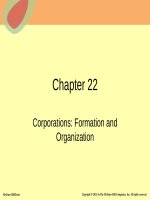Lecture Dynamic business law - Chapter 29: Checks and electronic fund transfers
Bạn đang xem bản rút gọn của tài liệu. Xem và tải ngay bản đầy đủ của tài liệu tại đây (278.19 KB, 13 trang )
Chapter 29
Checks and Electronic
Fund Transfers
Copyright © 2015 McGrawHill Education. All rights reserved. No reproduction or distribution without the prior written consent of McGrawHill Education.
Terminology Regarding Check Transactions
Draft: Order instrument; one party orders second party to pay
money to party listed on instrument
Drawer: Party who gives order to pay draft
Drawee: Party that must obey drawer’s order to pay draft
Payee: Party who receives benefit of drawer’s order; party
who receives money from draft
Check: Special draft that orders drawee (typically a bank) to
pay fixed amount of money on demand
292
Terminology Regarding Check Transactions
(Continued)
Cashier’s Check: check in which both drawer and drawee are same bank
Teller’s Check: Check drawn by one bank and usually drawn on another
bank
Traveler’s Check: Instrument payable on demand, drawn on/through a
bank, designated as a “traveler’s check”, and requires countersignature by
person whose signature appears on instrument
Money Order: Instrument stating that certain amount of money is to be
paid to a particular person (usually in same form as personal check)
Certified Check: Check accepted at bank at which it is drawn
293
Terminology Regarding Acceptance of Deposits
Depositary Bank: First bank that receives check for payment
Payor Bank: Bank on which check drawn; bank ultimately responsible
from granting funds for check
Collecting Bank: Any bank (except payor bank) that handles check during
collection process
Intermediary Bank: Any bank (except payor bank and depositary bank) to
which check transferred
294
Check Clearing For The 21st Century Act
Also known as “Check 21” or “Check Truncation” Act
Allows banks to forgo sending original checks as part of collection or
return process, and send a “truncated” version instead
Instead of original check, bank may send:
Substitute check (paper reproduction of original check)
By agreement, electronic image of check, along with data from
magnetic ink character recognition (MICR) line on original check
295
“Substitute Check” Requirements
Contains clear replication of front and back of original paper check
Bears MICR line with all information on original check’s MICR line
Conforms with generally applicable industry standard for paper stock,
dimensions, and other general qualities
Is suitable for automated processing in same manner as original paper
check
296
When Bank May Charge Customer’s Account
“Properly Payable” Rule: Bank may pay instrument only when authorized
by drawer, and payment does not violate agreement between bank and
customer
Wrongful Dishonor: Bank refuses to pay properly payable check; bank
incurs liability upon wrongful dishonor
Overdraft: If insufficient funds in customer’s account, bank may
Dishonor check, or
Create overdraft by paying check and charging account amount
overdrawn
StopPayment Order: Drawer orders bank to not pay check drawn on
customer’s account
PostDated Check: Customer can postdate check, but must give bank
notice of postdate
297
When Bank May Charge Customer’s Account
(Continued)
“Stale” Check (Definition): Check not presented to bank
within six (6) months of its date
If payee presents uncertified, stale check to bank, bank not
required to pay amount of check
If bank pays check in good faith, it may charge drawer’s
account
298
Forgeries and Alterations
Check Bearing Forged Signature: Generally, drawer not liable for forged
check, unless drawer substantially contributed to forgery
Check Bearing Forged Endorsement: Neither drawer nor drawer’s bank
liable for forged endorsement
Altered Check: If unauthorized change modifies obligation of party to
instrument, drawer generally not liable for altered amount, unless he/she
negligently contributed to alteration
299
Electronic Funds Transfer
(Definition): Money transferred by
electronic terminal, telephone, or computer
2910
Types of Electronic Funds Transfer (EFT) Systems:
Automated Teller Machines (ATMs): Machines connected to bank’s
computer located in convenient places, allowing customers to conduct
banking transactions without going into bank
“PointofSale” System: System that allows consumer to directly transfer
funds from bank account to merchant
Direct Deposits and Withdrawals: Preauthorized actions performed on
customer’s account through electronic terminal
“PaybyTelephone” System: Merchant allows customers to use telephone
to make payments/transfer funds
Online Banking: Banks grants customers electronic access to account data
to perform banking tasks (Example: Online transfer of funds)
2911
EMoney and Online Banking
“Digital Cash”: Money stored electronically (microchips, magnetic strips,
other computer media)
“StoredValue” Cards: Plastic cards with magnetic strips (similar to those
on credit cards/ATM cards) containing data regarding card value
“Smart Cards”: Cards that are the same size as regular check and ATM
cards, but that contain a microchip (instead of a magnetic strip), for storing
larger amounts of data
2912
The Right to Financial Privacy Act
Financial institutions, such as banks, may not give
a federal agency information regarding a person’s
finances without that person’s explicit consent or a
warrant
2913









